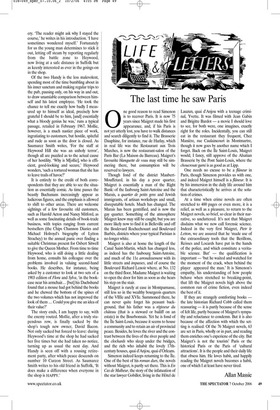The last time he saw Paris
One good reason to read Simenon is to recover Paris. It is now 75 years since Maigret made his first appearance, and, if his Paris is not yet utterly lost, you have to walk distances and search diligently to find it. The Brasserie Dauphine, for instance, rue de Harlay, which in real life was the Restaurant aux Trois Marches, is now the restaurant-salon of the Paris Bar (La Maison du Barreau). Maigret’s favourite blanquette de veau may still be simmering there, but consumption will be reserved to lawyers.
Though fond of the district MaubertMouffetard, in his day a poor quarter, Maigret is essentially a man of the Right Bank: of the faubourg Saint-Antoine and the Marais, a quartier de petits gens and Jewish immigrants, of artisan workshops and small, disreputable hotels. Much has changed. The Marais has been gentrified, and is now the gay quarter. Something of the atmosphere Maigret knew may still be caught, but you are more likely now to find it in Belleville and off the Boulevard Rochechouart and Boulevard Barbès, districts where your typical Parisian is no longer white.
Maigret is also at home the length of the Canal Saint-Martin, which has changed less, as indeed has the faubourg Saint-Antoine, and much of the 11e arrondissement with its little streets and impasses, and of course the Boulevard Richard Lenoir where, at No. 132 on the third floor, Madame Maigret is waiting to open the door for him as soon as she hears his step on the stair.
Maigret is rarely at ease in Montparnasse, still less so in the wealthy bourgeois quarters of the VIIIe and XVIe. Summoned there, he can never quite forget his peasant background, that his father was a régisseur du château (that is a steward or bailiff on an estate) in the Bourbonnais. Yet he is fond of the Île Saint-Louis, because it seems to house a community and to retain an air of provincial peace. Besides, he loves the river and the contrast between the lives of the river people and the clochards who sleep under the bridges, and the rich who inhabit the lovely 17thcentury houses, quai d’Anjou, quai d’Orleans. Simenon indeed keeps returning to the Île. One of the best of his roman durs, the novels without Maigret, is partly set there. This is En Cas de Malheur, the story of the infatuation of the star lawyer Gobillot, living in the Hôtel de Lauzun, quai d’Anjou with a teenage criminal, Yvette. It was filmed with Jean Gabin and Brigitte Bardot — a movie I should love to see, for both were, one imagines, exactly right for the roles. Incidentally, you can still eat in the restaurant they frequent, Chez Manière, rue Caulaincourt in Montmartre, though it now goes by another name which I forget. Back on the Île Saint-Louis, Maigret would, I fancy, still approve of the Alsatian Brasserie by the Pont Saint-Louis, where the choucroute garni is as good as at Lipp.
One needs no excuse to be a flâneur in Paris, though Simenon provides us with one, and indeed Maigret himself is a flâneur. It is by his immersion in the daily life around him that characteristically he arrives at the solution of crimes.
At a time when crime novels are often stretched to 400 pages or even more, it is a relief, as well as a pleasure, to return to the Maigret novels, so brief, so clear in their narrative, so uncluttered. It’s not that Maigret disdains what we now call forensic science. Indeed in the very first Maigret, Pietr le Letton, we are assured that he ‘made use of the extraordinary tools that the Berillons, Reisses and Locards have put in the hands of the police, and which constitute a veritable science. But’ — the qualification is important — ‘but he waited and watched for the moment of the crack, when behind the player appeared the man.’ It is Simenon’s empathy, his understanding of how people behave when stretched to breaking-point, that lift the Maigret novels high above the common run of crime fiction, even indeed the best of it.
If they are strangely comforting books the late historian Richard Cobb called them reassuring — it is partly because of the sense of felt life, partly because of Maigret’s sympathy and reluctance to condemn. But it is also because of the affection with which the setting is realised. Of the 76 Maigret novels, 63 are set in Paris, wholly or in part, and reading them enriches one’s experiene of the city. But Maigret’s is not the tourists’ Paris or the historical Paris or the Paris of ‘cultural attractions’. It is the people and their daily life that obsess him. He loves habit, and happily reading the Maigret novels becomes a habit, one of which I at least have never tired.
Allan Massie


















































































 Previous page
Previous page